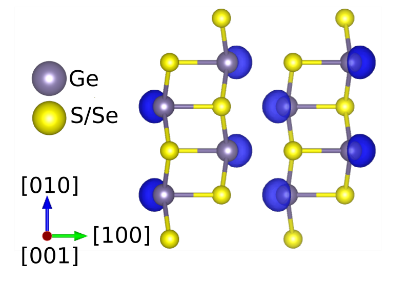Paper published on germanium sulfide and germanium selenide for solar cells

In September, our paper titled “Ge 4s2 Lone Pairs and Band Alignments in GeS and GeSe for photovoltaics” was published in the Journal of Materials Chemistry A. The work was written by PhD student Matthew Smiles, supervised by Prof Tim Veal, and is central to his project studying new materials with applications in photovoltaics. Matt is funded by the EPSRC Centre for Doctoral Training in New and Sustainable Photovoltaics.
Both GeS and GeSe are interesting materials from a photovoltaic perspective because they have ideal optical properties and a similar structure to antimony selenide, a promising material being studied by Dr Jon Major’s group in the Stephenson Institute of Renewable Energy (SIRE). Crystals of GeS and GeSe were grown in furnaces in the SIRE for this study. The paper showed the presence of the lone pair effect for both materials, something which has been shown to benefit photovoltaic performance in other materials. To do this the valence band spectrum of both materials was measured with coventional x-ray photoemission spectroscopy (XPS) and also hard x-ray photoemission spectroscopy (HAXPES) and compared to theoretical calculations performed by Dr Jonathan Skelton at the University of Manchester.
The XPS measurements allowed us to determine the secondary electron cut-off energy which could then be used to determine the position of the valence band maximum relative to the vacuum level. Using band gap values, the position of the conduction band could also be determined and so the natural band alignments between GeS or GeSe with potential solar cell window layers could be investigated.
The work is a fine example of the cross-discipline collaborations undertaken at the SIRE, with the samples grown with the help of Dr Phil Murgatroyd (now a postdoc at University of St Andrews), XPS measurements in the lab of Prof Vin Dhanak with the help from his PhD student Holly Edwards and Diamond Light Source HAXPES with the help of Huw Shiel, Dr Jack Swallow (now a postdoc at the University of Oxford), Leanne Jones and Dr Tom Featherstone in collaboration with the beamline scientists.